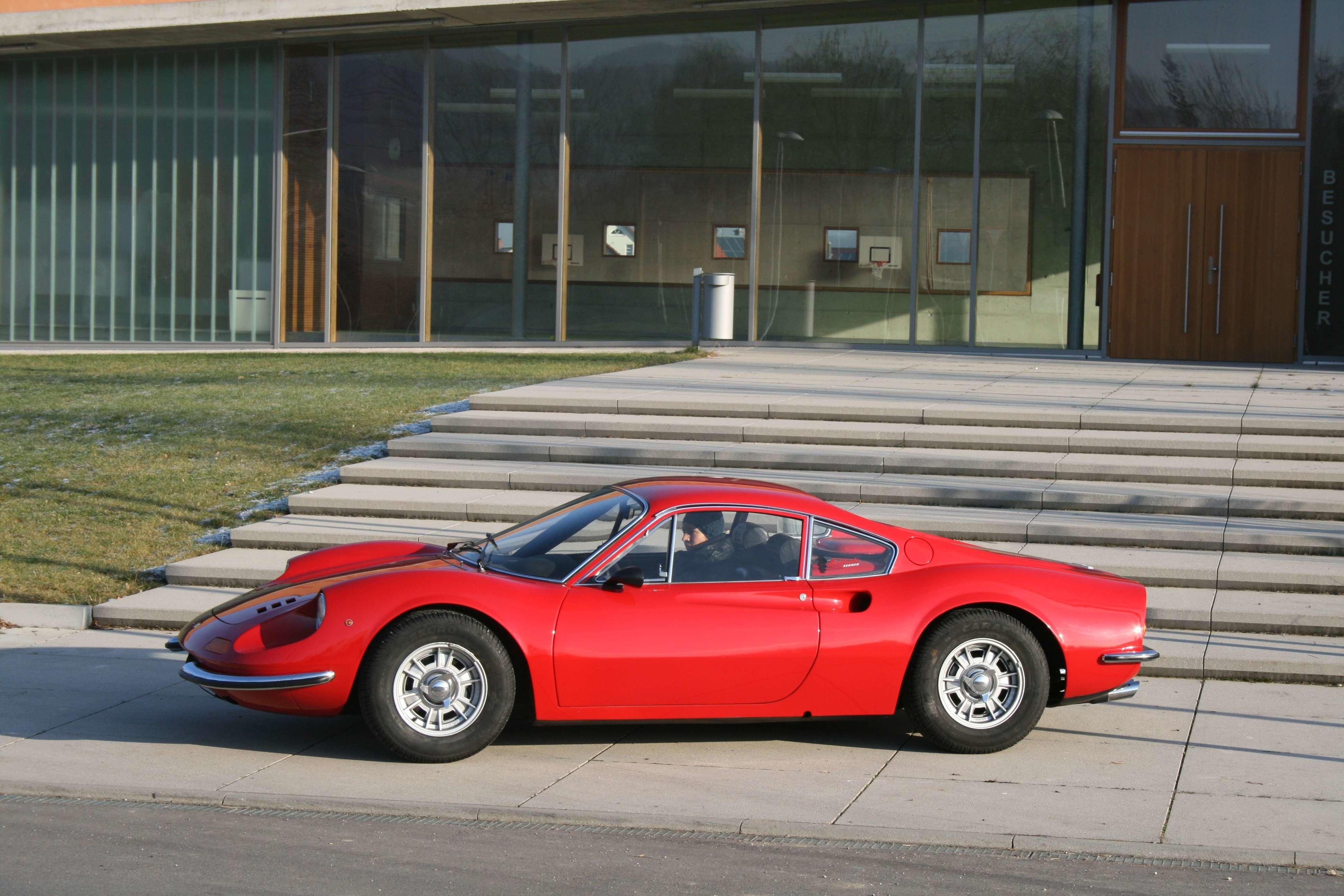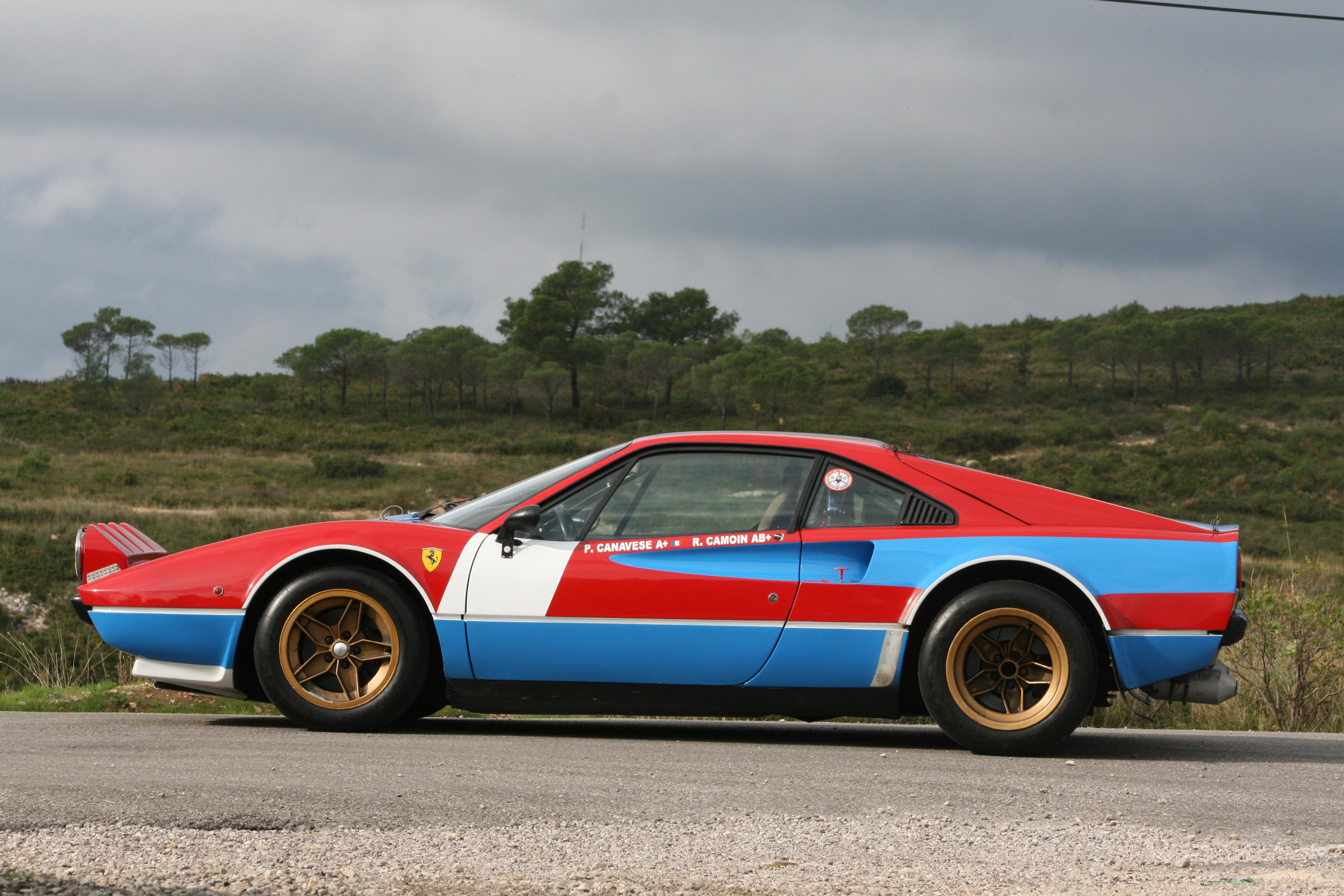Description It was the need for a production-based engine for the new Formula 2 that had prompted the introduction of a ‘junior’ Ferrari, the Dino 206 GT, at the Turin Motor Show in 1967. The latest in a line of Dino V6 ‘quad-cam’ engines stretching back to the late 1950s, the new unit proved as successful on the racetrack as in the showroom, Derek Bell and Ernesto Brambilla both winning races in the European Championship, while Andrea de Adamich triumphed in the 1968 Argentine Temporada series. Building on experience gained with its successful limited edition Dino 206 S sports-racer of 1966, Ferrari retained the racer’s mid-engined layout for the road car but installed the power unit transversely rather than longitudinally. A compact, aluminium-bodied coupé of striking appearance, the Pininfarina-styled Dino – named after Enzo Ferrari’s late son Alfredino Ferrari and intended as the first of a separate but related marque – was powered by a 2.0-litre, four-cam V6 driving via an in-unit five-speed transaxle. The motor’s 180bhp was good enough to propel the lightweight, aerodynamically-efficient Dino to 142mph, and while there were few complaints about the car’s performance, the high cost enforced by its aluminium construction hindered sales. A 2.4-litre version on a longer wheelbase – the 246 GT – replaced the original Dino 206 in late 1969. Built by Scaglietti, the body was now steel, and the cylinder block cast-iron rather than aluminium, but the bigger engine’s increased power – 195bhp at 7,600rpm – adequately compensated for the weight gain. The 246 was built in three series, referred to internally as “L,” “M,” and “E.” Series “L” cars, produced in late 1969 through 1970, have road wheels with a single knock-off spinner, front quarter bumpers that extend into the grille opening, and head rests mounted on the rear bulkhead. It was the need for a production-based engine for the new Formula 2 that had prompted the introduction of a ‘junior’ Ferrari, the Dino 206 GT, at the Turin Motor Show in 1967. The latest in a line of Dino V6 ‘quad-cam’ engines stretching back to the late 1950s, the new unit proved as successful on the racetrack as in the showroom, Derek Bell and Ernesto Brambilla both winning races in the European Championship, while Andrea de Adamich triumphed in the 1968 Argentine Temporada series. Building on experience gained with its successful limited edition Dino 206 S sports-racer of 1966, Ferrari retained the racer’s mid-engined layout for the road car but installed the power unit transversely rather than longitudinally. A compact, aluminium-bodied coupé of striking appearance, the Pininfarina-styled Dino – named after Enzo Ferrari’s late son Alfredino Ferrari and intended as the first of a separate but related marque – was powered by a 2.0-litre, four-cam V6 driving via an in-unit five-speed transaxle. The motor’s 180bhp was good enough to propel the lightweight, aerodynamically-efficient Dino to 142mph, and while there were few complaints about the car’s performance, the high cost enforced by its aluminium construction hindered sales. A 2.4-litre version on a longer wheelbase – the 246 GT – replaced the original Dino 206 in late 1969. Built by Scaglietti, the body was now steel, and the cylinder block cast-iron rather than aluminium, but the bigger engine’s increased power – 195bhp at 7,600rpm – adequately compensated for the weight gain. The 246 was built in three series, referred to internally as “L,” “M,” and “E.” Series “L” cars, produced in late 1969 through 1970, have road wheels with a single knock-off spinner, front quarter bumpers that extend into the grille opening, and head rests mounted on the rear bulkhead. A short run of Series “M” cars were produced in early 1971; these had five-bolt road wheels, an internal rear boot lid release catch, and seat-mounted headrests. Series “E” cars were produced from early 1971 to the end of production in 1974. They incorporated all the changes to the Series “M” ex
Description It was the need for a production-based engine for the new Formula 2 that had prompted the introduction of a ‘junior’ Ferrari, the Dino 206 GT, at the Turin Motor Show in 1967. The latest in a line of Dino V6 ‘quad-cam’ engines stretching back to the late 1950s, the new unit proved as successful on the racetrack as in the showroom, Derek Bell and Ernesto Brambilla both winning races in the European Championship, while Andrea de Adamich triumphed in the 1968 Argentine Temporada series. Building on experience gained with its successful limited edition Dino 206 S sports-racer of 1966, Ferrari retained the racer’s mid-engined layout for the road car but installed the power unit transversely rather than longitudinally. A compact, aluminium-bodied coupé of striking appearance, the Pininfarina-styled Dino – named after Enzo Ferrari’s late son Alfredino Ferrari and intended as the first of a separate but related marque – was powered by a 2.0-litre, four-cam V6 driving via an in-unit five-speed transaxle. The motor’s 180bhp was good enough to propel the lightweight, aerodynamically-efficient Dino to 142mph, and while there were few complaints about the car’s performance, the high cost enforced by its aluminium construction hindered sales. A 2.4-litre version on a longer wheelbase – the 246 GT – replaced the original Dino 206 in late 1969. Built by Scaglietti, the body was now steel, and the cylinder block cast-iron rather than aluminium, but the bigger engine’s increased power – 195bhp at 7,600rpm – adequately compensated for the weight gain. The 246 was built in three series, referred to internally as “L,” “M,” and “E.” Series “L” cars, produced in late 1969 through 1970, have road wheels with a single knock-off spinner, front quarter bumpers that extend into the grille opening, and head rests mounted on the rear bulkhead. It was the need for a production-based engine for the new Formula 2 that had prompted the introduction of a ‘junior’ Ferrari, the Dino 206 GT, at the Turin Motor Show in 1967. The latest in a line of Dino V6 ‘quad-cam’ engines stretching back to the late 1950s, the new unit proved as successful on the racetrack as in the showroom, Derek Bell and Ernesto Brambilla both winning races in the European Championship, while Andrea de Adamich triumphed in the 1968 Argentine Temporada series. Building on experience gained with its successful limited edition Dino 206 S sports-racer of 1966, Ferrari retained the racer’s mid-engined layout for the road car but installed the power unit transversely rather than longitudinally. A compact, aluminium-bodied coupé of striking appearance, the Pininfarina-styled Dino – named after Enzo Ferrari’s late son Alfredino Ferrari and intended as the first of a separate but related marque – was powered by a 2.0-litre, four-cam V6 driving via an in-unit five-speed transaxle. The motor’s 180bhp was good enough to propel the lightweight, aerodynamically-efficient Dino to 142mph, and while there were few complaints about the car’s performance, the high cost enforced by its aluminium construction hindered sales. A 2.4-litre version on a longer wheelbase – the 246 GT – replaced the original Dino 206 in late 1969. Built by Scaglietti, the body was now steel, and the cylinder block cast-iron rather than aluminium, but the bigger engine’s increased power – 195bhp at 7,600rpm – adequately compensated for the weight gain. The 246 was built in three series, referred to internally as “L,” “M,” and “E.” Series “L” cars, produced in late 1969 through 1970, have road wheels with a single knock-off spinner, front quarter bumpers that extend into the grille opening, and head rests mounted on the rear bulkhead. A short run of Series “M” cars were produced in early 1971; these had five-bolt road wheels, an internal rear boot lid release catch, and seat-mounted headrests. Series “E” cars were produced from early 1971 to the end of production in 1974. They incorporated all the changes to the Series “M” ex















Testen Sie LotSearch und seine Premium-Features 7 Tage - ohne Kosten!
Lassen Sie sich automatisch über neue Objekte in kommenden Auktionen benachrichtigen.
Suchauftrag anlegen